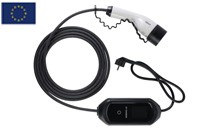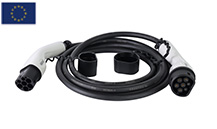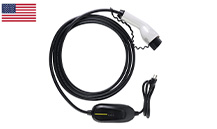Electric vehicles are developing rapidly, and the charging post is the common name of Electric Vehicle Supply Equipment (EVSE), the main role is to replenish the electric power for electric vehicles, which is equivalent to the refueling equipment for fuel cars.
Charging piles are divided into AC (alternating current) and DC (direct current) charging piles. The difference between AC and DC charging piles for EVs is that charging with DC piles is faster and takes less time. The power battery of electric vehicles can only receive direct current (DC) voltage, but the power supply of the grid is AC, which cannot charge electric vehicles directly, and needs to be converted from AC to DC. All AC charging piles need to pass through the vehicle charger, and then use the AC-DC rectifier conversion function of the vehicle charger to power the EV power battery; while the DC charging pile has an integrated power module, this conversion process can be directly converted in the pile, and the output DC power is directly supplied to the vehicle power battery.
The classification of electric vehicle charging equipment in the United States and Europe is different. The United States generally uses Level 1/2/3 to classify; other regions outside the United States use Mode 1/2/3/4 to distinguish.
Level 1/2/3 is mainly based on the size of the voltage at the input of the charging post. Level refers to the 120V charging post power supply, which uses a single-phase plug for household use in the U.S., with a power ranging from 1.4KW-1.9KW; Level 2 refers to the U.S. household high-voltage 208V or European 240V AC post power supply, with a higher charging power than Level 1 and a faster charging speed; Level 3 uses a high-voltage 208V or European 240V AC post power supply. Level 3 is the highest power and fastest charging speed among the three types of charging using DC charging piles.
Mode 1/2/3/4 are mainly classified according to the communication between charging posts and EVs. mode 1 uses portable chargers to directly connect EVs to the charging infrastructure, which cannot communicate without protection and has certain safety risks and has been banned in many countries. mode 2 has added protection devices to the charging connectors and communication exists between vehicles and EVs, with Mode 3 uses a wall-mounted or column-mounted AC charging post with fixed installation, which is inherently protected. mode 4 uses a DC charging post with fixed installation, which uses DC charging and features high charging current and fast charging speed, and requires the use of cables with higher safety. FAFA-E provides high power liquid-cooled charging cable for Mode 4 charging, which adopts liquid-cooling technology to dissipate heat and can make the wire diameter very small, providing 600A current-carrying capacity and faster charging speed.
FAFA-E provides EV portable chargers, including European standard 16A mode 2 portable charger, single-phase 32A double-head connector charger, and three-phase 32A double-head connector charger. Many friends are curious about what is 32A and what is single phase and three phase, FAFA-E will answer for you.
We often say that 32A charging represents the power of the fuse and the power that can be used before the fuse blows. The higher the charging power that can be used before the fuse blows, the faster the EV charging speed, which is the reason why 32A chargers charge faster than 16A chargers. Of course, faster charging speeds also mean thicker and bulkier EV charging cables.
So, what do the common single-phase and three-phase EV portable chargers refer to? Single-phase power generally has only one fire wire and zero wire, while three-phase power is composed of three fire wires. In the case of EV portable chargers, three-phase portable chargers can achieve faster charging than single-phase chargers, provided of course that your electric vehicle can support three-phase charging.






 简体中文
简体中文
